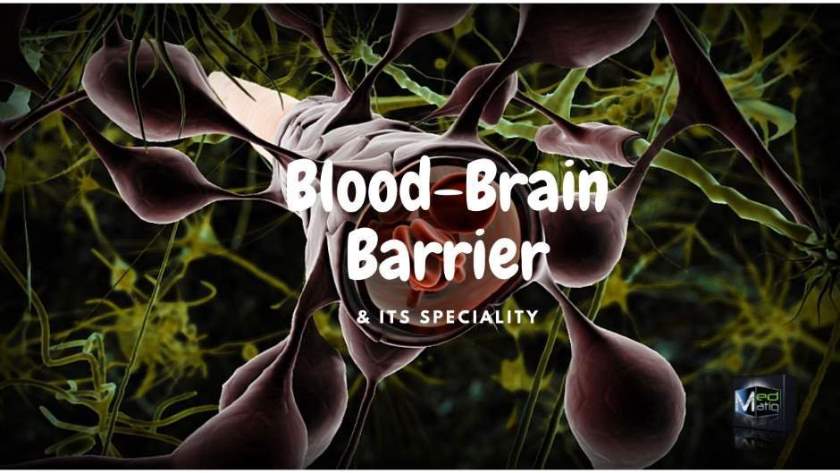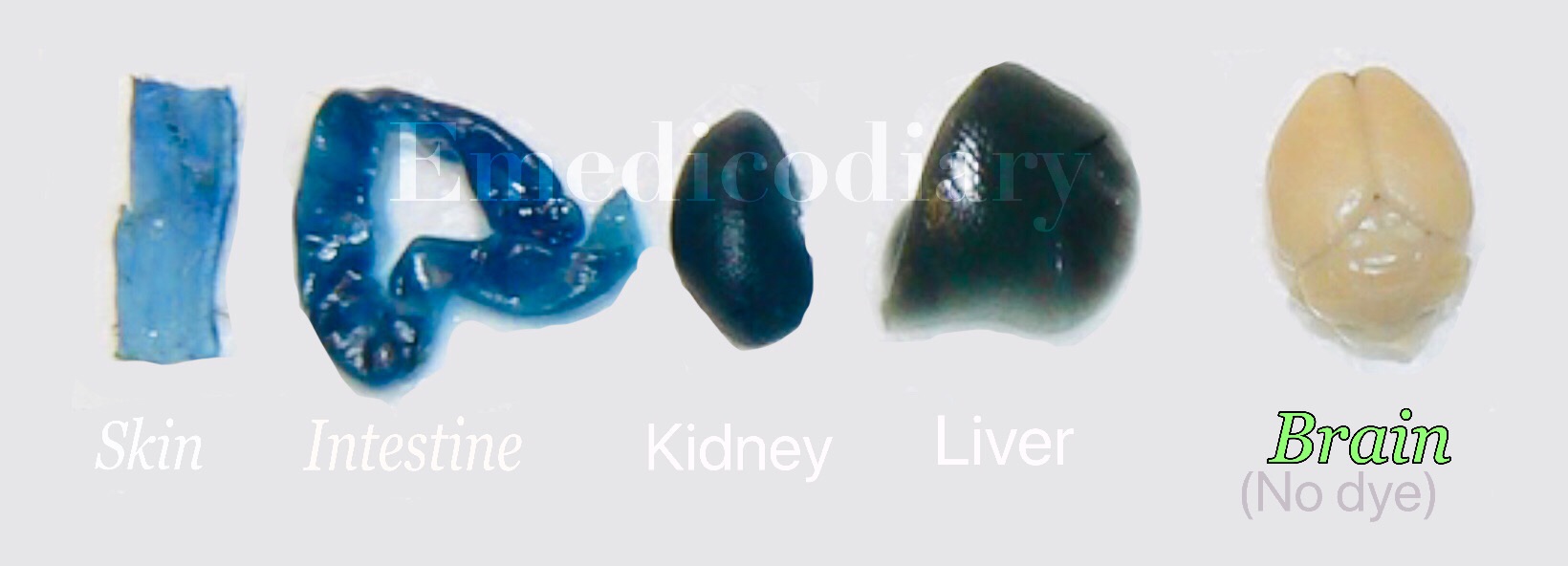Two barriers mainly exist within the brain & spinal cord i.e
• Blood-brain barrier
• Blood-CSF barrier
But remember there is no CSF- brain barrier. Components of CSF can easily enter into the neural tissues.
Blood CSF Barrier:
The blood-CSF barrier means the barrier between blood and CSF.
Capillaries within the choroid plexus forms the CSF from the ultrafiltration of plasma of blood.
Here the endothelial cells of blood vessel does not doesn’t have tight junction like that of Blood-Brain Barrier. But the choroid plexus is surrounded by specialized ependymal cells having tight junction within them which truly act as a barrier between the blood & CSF so-called as Blood CSF barrier.
In simple word,
Blood CSF Barrier is the barrier between CSF & blood capillaries of choroid plexus created by the specialized ependymal cells (surrounding the ventricles of the brain).
Blood-Brain Barrier (BBB)
The blood-brain barrier is noting but the partition created by the endothelial lining of blood vessels around the CNS with its unique features. This barrier is not like those physical barriers.
Blood vessels supplying the brain & spinal cord are quite different in the formation from the rest of the body. As we know, capillaries around the Brain & Spinal cord are Continous capillary, which means there is no gap or intercellular cleft between the endothelial cells lining the blood vessels. Moreover, the presence of the tight junctions between the endothelial cells makes these blood vessels so special.
Endothelial cells lining of capillaries of blood vessels of the Central Nervous System (Brain & Spinal cord) create the partition/ barrier between neurons/tissue of brain & blood. Thus, called the blood-brain barrier (BBB).
The endothelial cells of blood vessels supply the CNS are so designed that high size molecules, high polarity molecules and other toxin substances cannot cross the barrier.
Formation of blood-brain barrier (Components of Blood-Brain Barrier)
Blood-Brain Barrier is formed by
• Endothelial cells of blood vessels with the tight junction between them, which make them unique from other blood vessels.
• Continous Basement membrane of endothelial cells
• Partial covered by pericytes
• Foot process of astrocyte
The main important thing which forms Blood-Brain Barrier (BBB) is continuous basement membrane and continuous endothelial cells with tight junction within them which makes it very unique. Other structures like astrocytes are needed for the maintenance of the Blood-Brain Barrier.
The blood-brain barrier is so much powerful and well managed that, even if you inject blue dye into the mouse, it easily passes into other tissue rather than the brain, which can be clearly illustrated by the following picture.
Better For Understanding
|
Classification of capillaries
There are three types of capillaries in our bodies.
1. Continuous capillary
• Continous capillary is also called as somatic capillary.
• It is characterized by Endothelial cells and the basement membranes are continuous without any pores on its wall.
• This type of capillary is found in nervous tissue, muscles & skin, lungs
So, one of the important features of the blood-brain barrier is continuous capillary.
2. Fenestrated capillary
• It is also called as visceral capillary.
• The basement membrane is continuous but there are pores (Fenestrae) through the walls of endothelial cells.
• This type of capillaries is found in renal glomeruli, intestinal villi, endocrine glands & pancreas.
3. Sinusoidal capillaries
• It is also called Discontinuous capillary
• The lumen of this capillary is usually large in diameter than the other.
• Similarly, the basement membrane and endothelial cells lining is not continuous.
• This type of capillary is found in the liver, spleen & bone marrow.
|
Importance of Blood-Brain Barrier
Why blood-brain barrier important?
Well, our central nervous system (Brain & Spinal cord) is so special & delicate organ. As we know, neurons doesn't regenerate like other tissue. Thus, nervous tissue needs extra safety & protection. It prevent getting bloodborne pathogens & toxic substance into the brain tissue. So, Blood-Brain Barrier is important.
Similarly, another main importance of the blood-brain barrier is to maintain the nervous system homeostasis. The nervous system needs a stable environment. Components of blood fluctuated frequently like during physical stress, fasting the components of blood fluctuate from time to time.
Not only normal functioning Blood-Brain Barrier is required for the protection but also for the normal healthy brain function because the brain uses chemical signals to send messages. So, the brain needs to maintain its chemical homeostasis for which the Blood-Brain barrier is also important.
That means it keeps the precious balance of ions in the fluid, surrounding the cells so that the neurons fire action potentials & none of the chemical signals get confused.
Due to the presence of tight junction within the endothelial cells of the blood vessels of the brain, it helps to maintain the constant homeostasis for the normal functioning of the brain.
If molecules & ions could go through blood to brain tissue, then the chemical homeostasis will be disrupted.
Similarly, if neurotransmitters (like dopamine, acetylcholine) get into the blood, then no signal is generated within the nervous system. Neurotransmitters shouldn’t escape through blood circulation. Thus, to prevent the escape of neurotransmitters too, for maintaining normal neural homeostasis, Blood-Brain Barrier (BBB) is important.
Why is it difficult to treat brain disorders with drugs?
The blood-brain barrier even doesn’t permit the drugs used to treat the patients. Thus, it has been a great difficulty for doctors to treat the brain related patients as normal drugs doesn’t cross the Blood-Brain Barrier.
Even though, somehow the lipid-soluble drugs enter cross the Blood-Brain Barrier, there is efflux transporter within the endothelial cells with throw out such drugs, again back to blood.
Developed strategies to overcome the Blood-Brain Barrier
• Drugs injected directly through CSF, and there is no CSF-brain barrier.
• Making drugs with higher lipid soluble so that it can easily solubilize the cell membrane.
• Disrupting the tight junction partly by rays. Temporarily opening the blood-brain barrier by using ultrasound.
• Partially hacking the nutrient transporter and inhibiting the efflux transporter which throws out the steroid molecules back into blood.
If capillaries of brain vessels are so impermeable, then how the brain get nutrients?
Blood-Brain Barrier (BBB) is designed in such a way that, the basic needed thing can be still carried out into brain tissue by the presence of specific transporters.
(Permeability of Blood-Brain Barrier)
Substances that could permeable through Blood-Brain Barrier
• Water
• Oxygen
• Carbon dioxide
• Glucose
• Essential amino acids
• & other essential molecules to brain
Blood-Brain Barrier doesn’t allow large molecules like plasma protein, etc. That means all the substances bounded with plasma protein are also not permeable into the nervous tissue.
As we know, thyroid hormone, steroid hormones have two forms ie. free form & plasma protein bounded hormones.
That is free hormones can do cross the Blood-Brain Barrier but protein bounded hormones cannot cross the blood-brain barrier.
Blood-Brain Barrier (BBB) might do allow the highly lipid-soluble substances.
But high polarity substances ie. water-soluble substances are not permeable through Blood-Brain Barrier.
|
Parkinson’s disease is the neurodegenerative disorder due to damage in substantia nigra or in the nigrostriatal pathway leading to the decrease in dopamine concentration in basal ganglia.
The substantia nigra (contains dopaminergic neurons) which generate neurotransmitters (dopamine)
Nigrostriatal fibers that form a pathway for dopamine to the Caudate nucleus & putamen (part of basal ganglia)
|
In Parkinson’s disease, dopamine is not used for treatment, as it cannot cross the Blood-Brain Barrier, due to its high polarity.
Levo-dopamine (precursors of dopamine) is used as therapeutic because of its less polarity which makes it permeable through the blood-brain barrier.
Large molecules usually cannot cross the blood-brain barrier. But essential large molecules like glucose, amino acids are transported through the help of transporter protein present in the endothelial lining of Blood-Brain Barrier.
Specifically, For the glucose transport, there are presence of glucose transporters called GULT-1 in the endothelial cells of the Blood-Brain Barrier. As we know, GLUT-1 is glucose-dependent, not the insulin-dependent transporter.
Anyway, the level of insulin doesn’t affect the transport of glucose in the brain. By the help of GLUT-1 transporter, glucose is also transported into the nervous tissue.
| GLUT-4 which is found in muscle & adipose tissue is only insulin-dependent as without insulin glucose cannot enter into these cells. |
Some Specific Transporters present in Blood-Brain Barrier
• Glucose Transporter (GLUT-1)
• Amino-acid Transporter
• Na+-K+ ATPase System (Na+-K+ pump)
• Nucleotide & Nucleoside Transporter
• Monocarboxylate transporters (MCT1 and MCT2)
These Transporters are present within the endothelial lining of blood vessels (ie. regulating the essential molecules through the Blood-Brain Barrier.
What happens, when the Blood-Brain Barrier (BBB) breaks down or dysfunction?
There are certain conditions where this BBB can break down like
• Alzheimer’s diseases
• Stroke
• Multiple sclerosis
• Epilepsy
• Trauma to brain
• Parkinson’s disease
• Hyper High blood pressure
If blood-brain barrier dysfunction, then neural homeostasis (chemical ionic homeostasis needed for nerve impulse) will be disrupted. Neuron might start firing in an unusual manner or not supposed to fire impulses.
Similarly, unusual substances from the blood enter into the neural tissue. Protein (large molecules) also get into the tissue, increasing the osmotic pressure within the neural tissue. This is followed by water, leading to swelling & causes edema. Such edema is called vasogenic edema of the brain as edema occurs due to vascular process.
Extra fluid gets into the brain causing swelling & many more immune cells can get into the brain which can also read to auto-immune diseases. When immune cells get wrongly programmed, then instead of attacking the infection, they start to attack the part of your own tissues.
Kernicterus:
Similarly, in the case of infants, the Blood-Brain Barrier is not so well developed. And infants have a relatively high concentration of hemoglobin than adults. Fetal RBC usually gets destroy fast leading to an increase in no. of breakdowns of hemoglobins which leads to an increase in the concentration of free bilirubin.
Bilirubin is the catabolic breakdown product of hemoglobin. Free bilirubin is highly toxic & water-insoluble so it needed to bind with albumin (plasma protein) to be transported through the blood to the liver for its conjunction.
Usually, bilirubin is transported to the liver by plasma protein albumin. But due to excessive breakdown of fetal hemoglobin (HbF) leading to excessive formation of bilirubin but all these bilirubin could not be bounded with plasma protein.
These free bilirubin (not albumin bounded) can easily cross the immature Blood-Brain Barrier & penetrate the lipid-rich basal ganglia because of its lipid solubility and deposited here. Yellow coloring of basal ganglia & cerebral cortex occurs leading to damage to basal ganglia. This leads to clinical conditions called kernicterus.
Thus, kernicterus is the clinical condition characterized by the deposition of unconjugated bilirubin in basal ganglia. Infants are more prone to this, due to the immaturity of the Blood-Brain Barrier.


Comments (0)